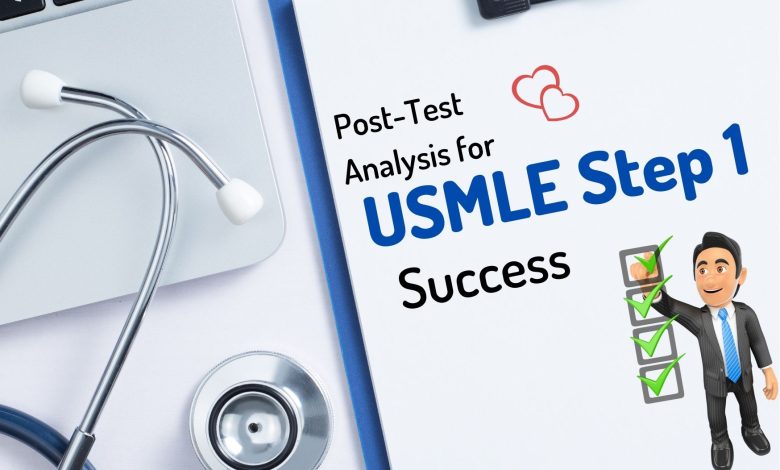Introduction
The Step 1 exam is a critical milestone for medical students, and achieving success requires more than just studying hard. The post-test analysis is the process of reviewing your performance on a practice exam or the actual USMLE Step 1 in order to identify your strengths and weaknesses. By delving into the key components of the exam and understanding how to leverage post-test analysis effectively, students can develop targeted study plans, identify knowledge gaps, refine test-taking strategies, and ultimately increase their chances of success.
Understanding the Step 1 Exam
Before diving into post-test analysis, it is crucial to comprehend the format, structure, content areas, and scoring system of the Step 1 exam. This section provides an overview, ensuring a solid foundation for effective analysis and preparation.
Preparing for Post-Test Analysis
To make the most of the post-test analysis, students need to prepare appropriately. This section discusses key steps to take before engaging in analysis, including collecting and organizing data, utilizing performance metrics, reviewing test questions and answers, and seeking feedback and advice from mentors or peers.
Why is post-test analysis important for USMLE Step 1?
The USMLE Step 1 is a challenging exam, and it is important to make the most of your study time. Post-test analysis can help you to do this by identifying the areas where you need to focus your studies. It can also help you to identify your strengths so that you can build on your knowledge and confidence.
How to conduct post-test analysis for USMLE Step 1
There are three steps involved in conducting post-test analysis for USMLE Step 1:
-
Review your score report.
Your score report will provide you with a breakdown of your performance on each of the content areas tested on the USMLE Step 1. This information can help you to identify your strengths and weaknesses.
-
Identify your strengths and weaknesses.
Once you have reviewed your score report, you need to identify your strengths and weaknesses. This can be done by carefully reviewing the questions that you answered correctly and incorrectly. For each question that you answered incorrectly, take some time to understand why you answered it incorrectly. This will help you to identify the areas where you need to focus your studies.
-
Develop a study plan.
Once you have identified your strengths and weaknesses, you need to develop a study plan that will help you to improve your performance in the areas where you need to focus your studies. Your study plan should be specific and measurable, and it should be realistic and achievable.
The benefits of post-test analysis for USMLE Step 1

The post-test analysis is a powerful tool that offers numerous benefits to Step 1 test-takers. By examining the results of practice tests and identifying areas for improvement, students can optimize their study plans, strengthen weak areas, and build effective test-taking strategies. This section explores the advantages of post-test analysis and how it contributes to Step 1 success.
There are several benefits to conducting post-test analysis for USMLE Step 1. These benefits include:
-
Increased understanding of your strengths and weaknesses:
By reviewing your score report and identifying the questions that you answered correctly and incorrectly, you can get a better understanding of your strengths and weaknesses. This information can then be used to focus your studies on the areas where you need the most improvement.
-
Improved study efficiency:
By focusing your studies on your weaknesses, you can improve your study efficiency. This means that you will be spending your time studying the material that will help you the most on the exam.
-
Increased confidence on test day:
Knowing your strengths and weaknesses can help you to feel more confident on test day. This is because you will know that you have prepared for the areas where you are likely to struggle.
In addition to these benefits, post-test analysis can help you identify areas where you need to improve your test-taking skills. For example, if you find that you are making careless mistakes, you can focus on developing strategies to avoid these mistakes.
Overall, post-test analysis is a valuable tool that can help you to improve your performance on the USMLE Step 1. By following the tips in this article, you can increase your chances of success on the exam. For more content keep visiting here.
Conclusion
The post-test analysis is an important part of preparing for the USMLE Step 1. By following the three steps outlined in this article, you can identify your strengths and weaknesses, develop a study plan, and improve your performance on the exam.
How to get started with post-test analysis for USMLE Step 1
There are a few things you can do to get started with post-test analysis for USMLE Step 1:
- Take a practice exam: This will give you a baseline score and help you to identify your strengths and weaknesses.
- Review your score report. Pay attention to the areas where you scored well and the areas where you scored poorly.
- Identify your strengths and weaknesses. Once you have reviewed your score report, you need to identify your strengths and weaknesses. This can be done by carefully reviewing the questions you answered correctly and incorrectly.
- Develop a study plan. Once you have identified your strengths and weaknesses, you need to develop a study plan that will help you to improve your performance in the areas where you need to focus your studies.
Resources for post-test analysis for USMLE Step 1
There are a number of resources available to help you with post-test analysis for USMLE Step 1. These resources include:
- The USMLE website: The USMLE website provides a number of resources for post-test analysis, including a score report interpretation guide and a list of practice exams.
- Kaplan Medical: Kaplan Medical offers a variety of resources for post-test analysis, including a score report interpretation guide and a post-test analysis tool.
- First Aid for the USMLE Step 1: First Aid for the USMLE Step 1 includes a chapter on post-test analysis, helping you understand the process better. It can also provide valuable insights into writing an effective ERAS personal statement.For more information and tips on crafting a compelling ERAS personal statement. This page offers in-depth guidance and examples to help you make your application stand out.
I hope this article has helped you to understand the importance of post-test analysis for USMLE Step 1 success. By following the tips in this article, you can improve your understanding of your strengths and weaknesses, develop a study plan, and increase your chances of success on the exam.



